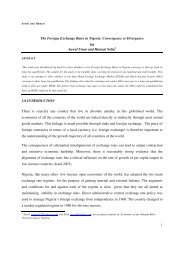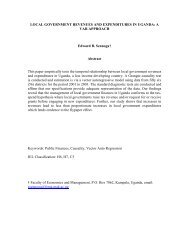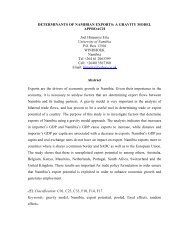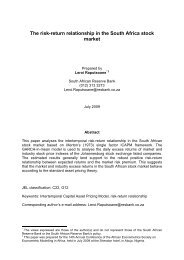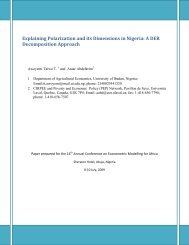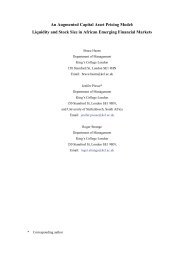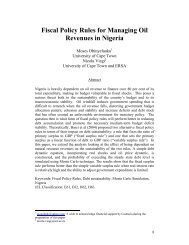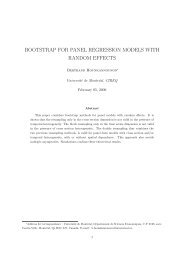Dynamic Effects of Monetary Policy Shocks in Malawi* - African ...
Dynamic Effects of Monetary Policy Shocks in Malawi* - African ...
Dynamic Effects of Monetary Policy Shocks in Malawi* - African ...
You also want an ePaper? Increase the reach of your titles
YUMPU automatically turns print PDFs into web optimized ePapers that Google loves.
post-1994 period, which allowed the Malawi Kwacha to respond freely to monetary variables.The response <strong>of</strong> output to exchange rate shocks, while still significant, is now less pronouncedcompared to the full sample. Thus, the impact <strong>of</strong> exchange rate shocks on policy goals is weaker<strong>in</strong> the truncated model although the exchange rate as a monetary policy transmission channel isnow apparent. Second, the significant response <strong>of</strong> M2 to bank rate shocks is more pronounced <strong>in</strong>the truncated sample. This underl<strong>in</strong>es the importance <strong>of</strong> monetary policy <strong>in</strong> the flexible exchangerate regime. Third, the significant output response to unexpected changes <strong>in</strong> bank lend<strong>in</strong>g is morepronounced <strong>in</strong> the truncated model, highlight<strong>in</strong>g the importance <strong>of</strong> bank lend<strong>in</strong>g as a standalonechannel <strong>of</strong> monetary transmission.To determ<strong>in</strong>e the proportion <strong>of</strong> fluctuations <strong>in</strong> a given variable that is caused by different shocks,variance decompositions <strong>of</strong> each variable <strong>in</strong> the composite model with a truncated sample arecomputed at forecast horizons <strong>of</strong> 1 to 5 years (see Table 4.2). The table shows that besides ownshocks, output fluctuations are largely attributed to M2 up to about a year, exchange rates atabout 2 years and bank lend<strong>in</strong>g from about 3 years and beyond. Collectively, bank lend<strong>in</strong>g,exchange rates and M2 account for 8.12 percent <strong>of</strong> the fluctuations <strong>in</strong> output after a year, 19.4percent after 2 years, 28 percent after three years and 36.9 percent after 5 years. Exclud<strong>in</strong>g ownshocks, variations <strong>in</strong> consumer prices are mostly accounted for by exchange rates up to about 3years and by bank lend<strong>in</strong>g thereafter. M2 accounts for less than 1 percent <strong>of</strong> the fluctuations <strong>in</strong>consumer prices across the forecast horizon, imply<strong>in</strong>g that shocks <strong>in</strong> aggregate money supply arenot responsible for <strong>in</strong>flation <strong>in</strong> Malawi. Consistent with earlier f<strong>in</strong>d<strong>in</strong>gs, consumer prices accountfor a larger proportion <strong>of</strong> the fluctuations <strong>in</strong> both bank rate and reserve money fluctuations, giventhe two policy goals, reconfirm<strong>in</strong>g that the primary goal <strong>of</strong> monetary policy <strong>in</strong> Malawi is pricestability, though the output goal is also pursued.4.4. Robustness CheckWhile all models are subjected to robustness checks, we report here results <strong>of</strong> the estimatedcomposite model from the truncated sample only. Structural estimates <strong>of</strong> the coefficients <strong>in</strong>matrices A and B <strong>of</strong> the model are presented <strong>in</strong> Table C4 <strong>of</strong> Appendix C. The table shows thatnearly all coefficients <strong>in</strong> the model have standard errors with values <strong>of</strong> less than one, imply<strong>in</strong>gthat they are efficient and hence form a solid basis for measur<strong>in</strong>g monetary policy shocks. Inaddition, 12 <strong>of</strong> the 17 structural coefficients have correct signs. Inverse roots <strong>of</strong> the characteristicAR polynomial for the determ<strong>in</strong>ation <strong>of</strong> stability (stationarity) <strong>of</strong> the model are reported <strong>in</strong> TableC5 <strong>of</strong> Appendix C. The table shows that all <strong>in</strong>verse roots <strong>of</strong> the characteristic AR polynomialhave modulus less than one and they lie <strong>in</strong>side the unit circle, <strong>in</strong>dicat<strong>in</strong>g that at the chosen laglength (<strong>of</strong> order three), the estimated model is stationary or stable. F<strong>in</strong>ally, serial correlation testresults reported <strong>in</strong> Table C6 <strong>of</strong> Appendix C show no evidence <strong>of</strong> serious serial correlation <strong>in</strong> themodel. Thus, the composite model with a truncated sample is robust and its <strong>in</strong>ferences can berelied upon.29 | P a g e



